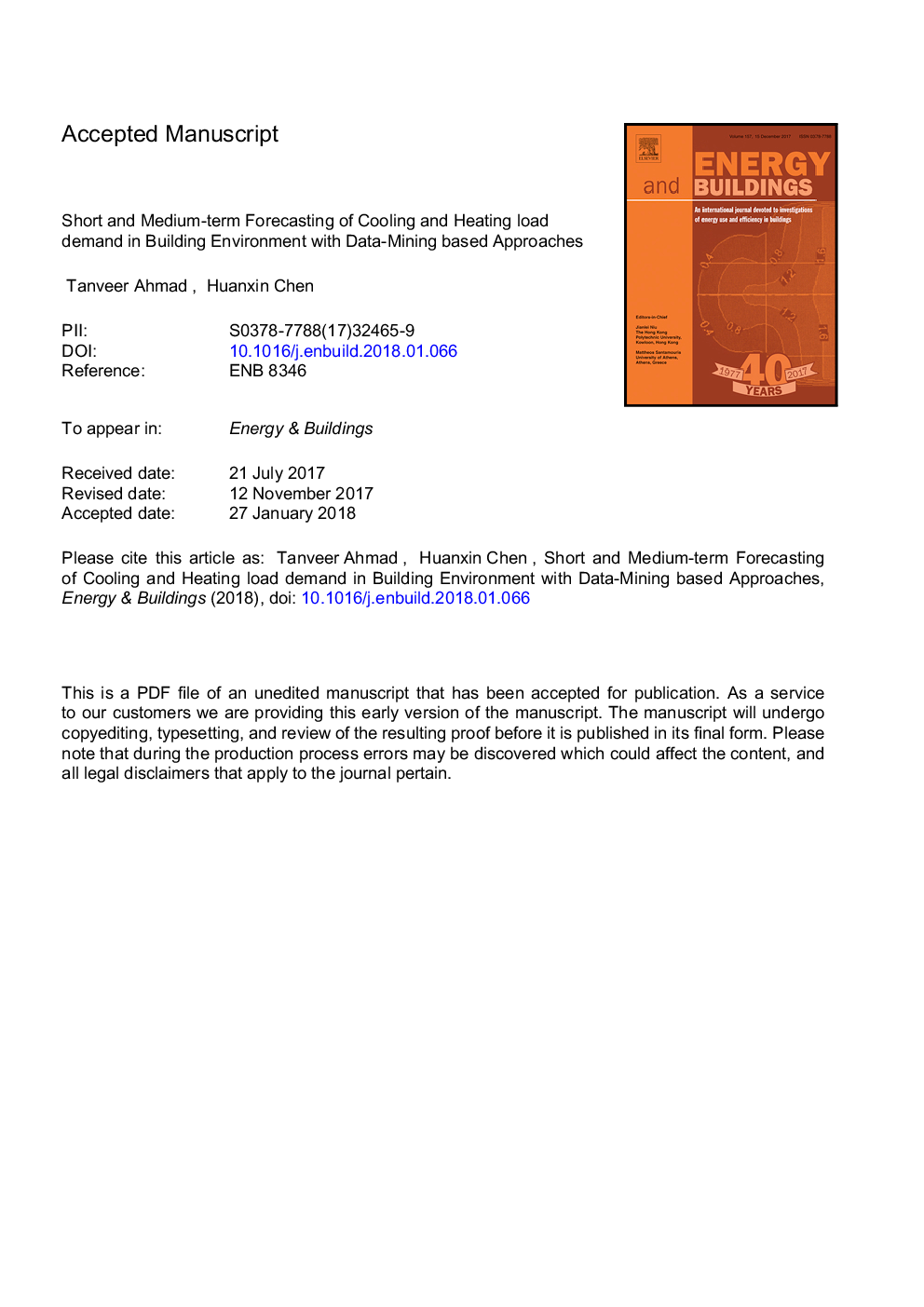| کد مقاله | کد نشریه | سال انتشار | مقاله انگلیسی | نسخه تمام متن |
|---|---|---|---|---|
| 6728778 | 1428924 | 2018 | 48 صفحه PDF | دانلود رایگان |
عنوان انگلیسی مقاله ISI
Short and medium-term forecasting of cooling and heating load demand in building environment with data-mining based approaches
ترجمه فارسی عنوان
پیش بینی کوتاه مدت و متوسط مدت تقاضای خنک کننده و گرمای بار در محیط ساختمان با رویکرد مبتنی بر داده ها
دانلود مقاله + سفارش ترجمه
دانلود مقاله ISI انگلیسی
رایگان برای ایرانیان
کلمات کلیدی
رویکرد مبتنی بر داده ها، پمپ حرارتی منبع آب، تجزیه خوشه بندی، پیش بینی بار،
ترجمه چکیده
در این مقاله، روشهای مبتنی بر داده کاوی مبتنی بر شش مدل برای پیش بینی دقیق گرمایش و تقاضای خنک کننده حرارت پمپ حرارت منبع آب، با هدف افزایش دقت پیش بینی و مدیریت بار آینده در نظر گرفته شده است. مدل پیشنهادی به منظور ساده سازی تعمیم به ساختمان های دیگر، با استفاده از اندازه گیری های قابل دسترس در تعداد کمی از متغیرهای مربوط به عملیات پمپ حرارت منبع آب در محیط ساختمان، توسعه یافته است. شش مدل عبارتند از: بذر درخت، رگرسیون فرآیند گاوسی، رگرسیون خطی چندگانه، درخت بذور، درخت تقویت شده و شبکه عصبی. پارامتر ورودی شامل دوره های تعیین شده، داده های هواشناسی بیرونی و شرایط بارگذاری پمپ حرارتی منبع آب بود. خروجی مصرف برق مصرفی پمپ گرمای منبع آب بود. در این مطالعه، شبیه سازی ها در سه جلسه - 7 روز، 14 روز و یک ماه از 8 تا 7 آگوست 2016 انجام شد. دقت پیش بینی مدل های داده کاوی با استفاده از شاخص های متنوع اندازه گیری شد. شاخص های عملکردی که در ارزیابی عملکرد پیش بینی استفاده شد عبارتند از: میانگین خطای مطلق، ضریب همبستگی، ضریب تغییر، خطای متوسط مربعات خطا، خطای متوسط مربع و میانگین خطای درصد مطلق. میانگین خطای درصد مطلق برای پیش بینی تقاضای انرژی آینده 7 روزه از بذر درخت، رگرسیون گاوسی، درخت غله، درخت تقویت شده، شبکه عصبی و رگرسیون خطی چندگانه به ترتیب 3.544٪، 405٪، 703٪، 1.928٪، 2.592٪ و 13.053٪ به ترتیب. علاوه بر این، هنگامی که عملکرد مدل داده کاوی با مطالعات موجود مقایسه شد، میانگین خطای درصد مطلق 2.515٪ برای اولین جلسه 7 روزه یافت شد. نتایج همچنین نشان داد که شش مدل در پیش بینی رفتار غیرطبیعی و تقاضای خنک کننده و حرارت در آینده در محیط ساختمان موثر بوده است.
موضوعات مرتبط
مهندسی و علوم پایه
مهندسی انرژی
انرژی های تجدید پذیر، توسعه پایدار و محیط زیست
چکیده انگلیسی
This paper depicted the novel data mining based methods that consist of six models for predicting accurate future heating and cooling load demand of water source heat pump, with the objective of enhancing the prediction accuracy and the management of future load. The proposed model was developed to ease generalization to other buildings, by making use of readily available measurements of a comparatively small number of variables related to water source heat pump operation in the building environment. The six models are - tree bagger, Gaussian process regression, multiple linear regression, bagged tree, boosted tree and neural network. The input parameter comprised the prescribed period, external climate data and the diverse load conditions of water source heat pump. The output was electrical power consumption of water source heat pump. In this study, simulations were conducted in three sessions - 7-day, 14-day and 1-month from 8th July to 7th August 2016. The forecast precisions of data mining models were measured by diverse indices. The performance indices which were used in assessing the prediction performance were - mean absolute error, coefficient of correlation, coefficient of variation, root mean square error, mean square error and mean absolute percentage error. The mean absolute percentage error results for 7-day future energy demand forecasting from tree bagger, Gaussian process regression, bagged tree, boosted tree, neural network and multiple linear regression were 3.544%, 0.405%, 1.703%, 1.928%, 2.592% and 13.053%, respectively. Moreover, when the proposed data mining model performance was compared with the existing studies, the mean absolute percentage error of 2.515% was found out for the first session, 7-day. The results also showed that the six models were efficient in foreseeing the abnormal behavior and future cooling and heating load demand in the building environment.
ناشر
Database: Elsevier - ScienceDirect (ساینس دایرکت)
Journal: Energy and Buildings - Volume 166, 1 May 2018, Pages 460-476
Journal: Energy and Buildings - Volume 166, 1 May 2018, Pages 460-476
نویسندگان
Tanveer Ahmad, Huanxin Chen,
